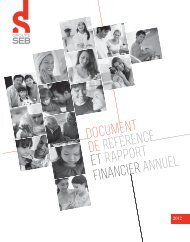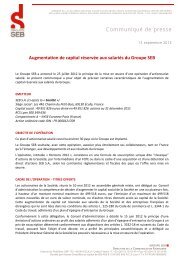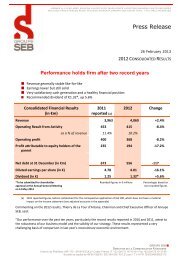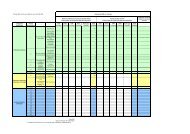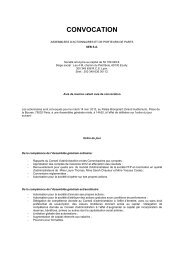Financial Report and Registration Document 2010 - Groupe Seb
Financial Report and Registration Document 2010 - Groupe Seb
Financial Report and Registration Document 2010 - Groupe Seb
Create successful ePaper yourself
Turn your PDF publications into a flip-book with our unique Google optimized e-Paper software.
3 NOTES<br />
CONSOLIDATED FINANCIAL STATEMENTS<br />
TO THE CONSOLIDATED FINANCIAL STATEMENTS<br />
No items of property, plant or equipment have been revalued.<br />
In accordance with IAS 17 – Leases, finance leases that transfer substantially<br />
all the risks <strong>and</strong> rewards incidental to ownership of an asset are recognised<br />
in property, plant <strong>and</strong> equipment for an amount corresponding to the lower<br />
of the fair value of the leased asset <strong>and</strong> the present value of the minimum<br />
lease payments.<br />
A liability for the same amount is recorded under “Finance lease liabilities”.<br />
1.4.3. Impairment of long-lived assets<br />
Under IAS 36 – Impairment of Assets, the recoverable amount of property,<br />
plant <strong>and</strong> equipment <strong>and</strong> intangible assets must be measured at each<br />
period-end or whenever there is an indication that the asset may be impaired.<br />
Assets with an indefinite life – corresponding in the case of <strong>Groupe</strong> SEB to<br />
goodwill <strong>and</strong> trademarks – are tested for impairment at least once a year.<br />
Assets with a finite life are tested whenever events or circumstances indicate<br />
that their carrying amount may not be recovered.<br />
Impairment tests are performed at the level of each Cash-Generating<br />
Unit (CGU). A CGU is defined as the smallest identifiable group of assets<br />
that generates cash inflows that are largely independent of the cash inflows<br />
from other assets or groups of assets. The fair value of CGUs is determined<br />
by the discounted cash fl ows method. An impairment loss is recognised<br />
for any excess of an asset’s carrying amount over its recoverable amount.<br />
Recoverable amount corresponds to the higher of the asset’s fair value less<br />
costs to sell <strong>and</strong> its value in use. The impairment loss is allocated to reduce<br />
the carrying amount of goodwill <strong>and</strong> then ratably to the other assets of the<br />
CGU based on their respective carrying amounts.<br />
The capitalised amount of development projects in progress is also tested<br />
for impairment.<br />
Impairment losses on CGUs <strong>and</strong> on assets with an indefinite useful life are<br />
recorded in “Other operating expense”.<br />
At <strong>Groupe</strong> SEB, CGUs correspond to individual production sites, broken<br />
down where appropriate by product family. The assets allocated to each<br />
CGU correspond mainly to tooling <strong>and</strong> other manufacturing assets (primarily<br />
buildings <strong>and</strong> machinery). Marketing subsidiaries <strong>and</strong> integrated<br />
manufacturing <strong>and</strong> sales entities are each treated as separate CGUs, but<br />
marketing subsidiaries that share resources are combined in a single CGU.<br />
Provisions for impairment of non-fi nancial assets other than goodwill are<br />
reviewed at each annual <strong>and</strong> interim period-end <strong>and</strong> adjusted as necessary.<br />
1.4.4. <strong>Financial</strong> instruments<br />
<strong>Financial</strong> instruments are accounted for in accordance with IAS 39 – <strong>Financial</strong><br />
Instruments: Recognition <strong>and</strong> Measurement.<br />
<strong>Financial</strong> assets <strong>and</strong> liabilities are recognised in the balance sheet when<br />
the Group becomes a party to the contractual provisions of the instrument.<br />
They are initially recognised at cost, corresponding to the fair value of the<br />
consideration paid or received plus external transaction costs that are<br />
directly attributable to the acquisition or issue of the fi nancial asset or<br />
financial liability.<br />
A) FINANCIAL ASSETS<br />
<strong>Financial</strong> assets consist of shares in subsidiaries <strong>and</strong> affiliates, as well as<br />
operating receivables, debt securities <strong>and</strong> other cash equivalents classified<br />
as current assets.<br />
Available-for-sale financial assets are assets that are intended to be held<br />
for an indefi nite period but which may be sold in response to changes<br />
in market interest rates or liquidity needs. They comprise investments in<br />
non-consolidated companies.<br />
At each period-end, they are measured at fair value <strong>and</strong> the resulting<br />
unrealised gain or loss is recognised directly in equity. When the assets are<br />
sold or there is objective evidence of impairment, the cumulative gains <strong>and</strong><br />
losses previously recognised in equity are reclassified to profit.<br />
Held-to-maturity investments are financial assets with a fixed maturity<br />
that the Group has the positive intention <strong>and</strong> ability to hold to maturity.<br />
They are measured at amortised cost, determined by the effective interest<br />
method.<br />
B) FINANCIAL LIABILITIES<br />
<strong>Financial</strong> liabilities comprise borrowings <strong>and</strong> other financing, including bank<br />
overdrafts, <strong>and</strong> operating liabilities.<br />
Borrowings <strong>and</strong> other financial liabilities are measured at amortised cost,<br />
determined by the effective interest method.<br />
When interest rate risks on financial liabilities are hedged by swaps qualifying<br />
as cash flow hedges, the swaps are also recognised in the balance sheet at<br />
fair value. The effective portion of changes in their fair value is recognised<br />
directly in equity <strong>and</strong> the ineffective portion is recognised in profit.<br />
C) DERIVATIVE INSTRUMENTS<br />
Market risks (interest rate, currency <strong>and</strong> commodity price risks) are hedged,<br />
generally through the use of derivative instruments.<br />
In accordance with IAS 32 <strong>and</strong> IAS 39, derivative instruments are measured<br />
at fair value.<br />
The accounting treatment of changes in fair value depends on the future use<br />
of the derivative <strong>and</strong> the resulting accounting classification.<br />
Derivative instruments designated as the hedging instrument in a hedging<br />
relationship may be classified as either fair value or cash flow hedges.<br />
a fair value hedge is a hedge of the exposure to changes in fair value of<br />
a recognised asset or liability or an unrecognised firm commitment that<br />
is attributable to a particular risk <strong>and</strong> could affect profit;<br />
a cash flow hedge is a hedge of the exposure to variability in cash flows<br />
that is attributable to a particular risk associated with a recognised asset<br />
or liability or a highly probable forecast transaction <strong>and</strong> could affect profit.<br />
The gain or loss arising from remeasurement at fair value of derivative<br />
instruments designated as fair value hedges is recognised in profit, offsetting<br />
all or part of the gain or loss recognised on the hedged item.<br />
In the case of cash fl ow hedges, the effective portion of the gain or loss<br />
arising from remeasurement of the derivative instrument at fair value is<br />
recognised in equity <strong>and</strong> the ineffective portion is recognised in profi t.<br />
The cumulative gains <strong>and</strong> losses on cash flow hedges recognised directly<br />
in equity are reclassified into profit when the hedged item affects profit.<br />
Hedge accounting is applied when:<br />
the hedging relationship is formally designated <strong>and</strong> documented at the<br />
inception of the hedge;<br />
the hedge is expected to be highly effective <strong>and</strong> is determined actually<br />
to have been highly effective throughout the financial reporting periods<br />
for which it was designated.<br />
70 FINANCIAL REPORT AND REGISTRATION DOCUMENT <strong>2010</strong> GROUPE SEB



